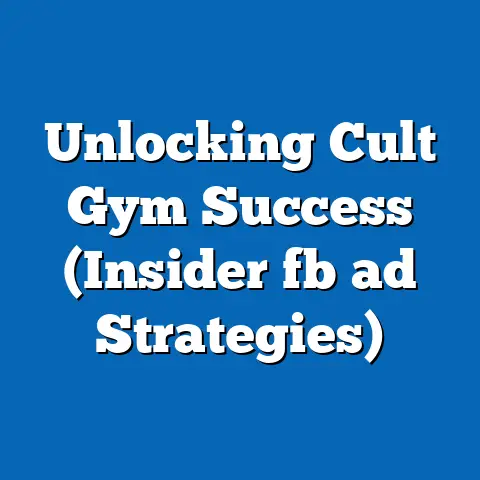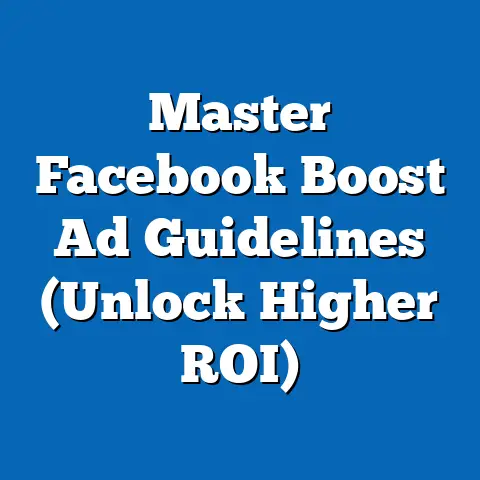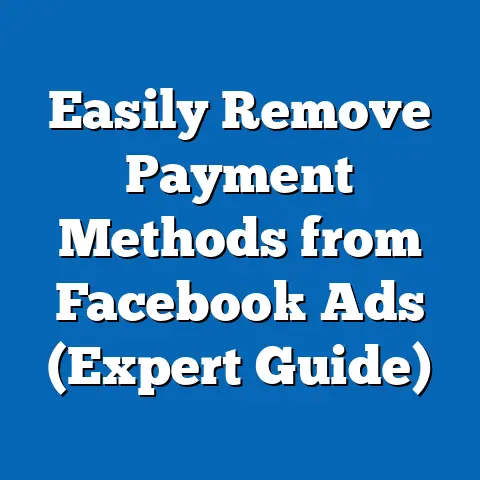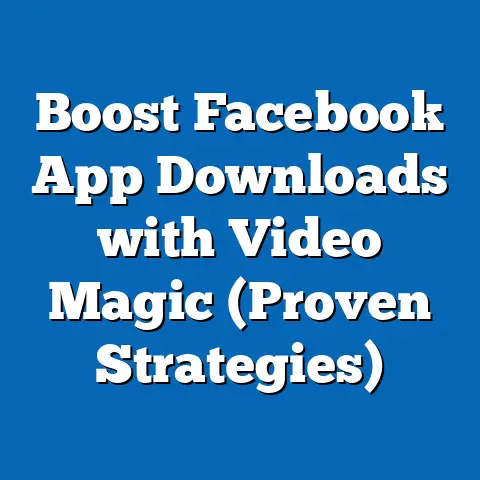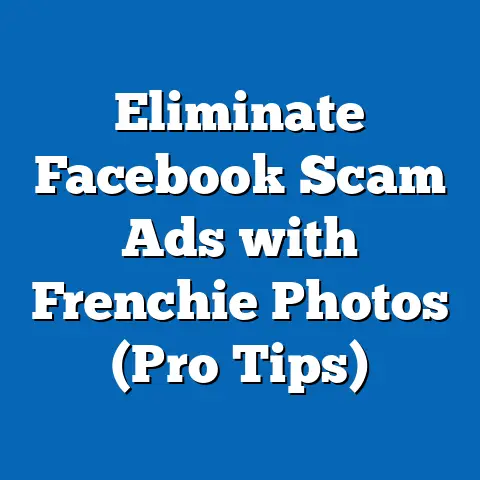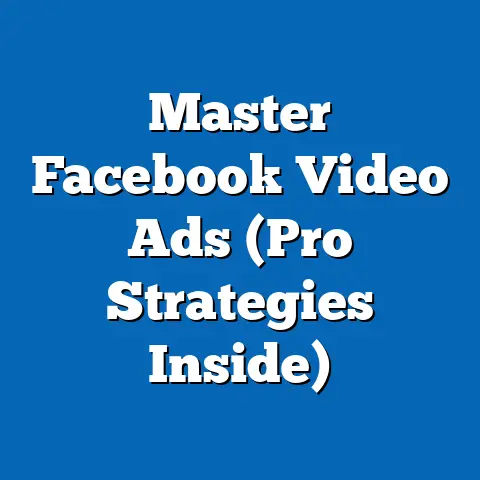Unlock In-Stream Ads on Facebook (Expert Implementation Guide)
In the world of digital advertising, there’s a certain craftsmanship involved, a meticulous attention to detail that separates the merely adequate from the truly exceptional. It’s akin to a master carpenter carefully selecting the right wood, knowing its grain and how it will respond to the chisel, or a painter meticulously mixing colors to evoke a specific emotion. In-stream ads on Facebook demand that same level of precision and artistry. They aren’t just about throwing a video out there and hoping for the best; they’re about crafting an experience that seamlessly integrates into the viewer’s flow, capturing their attention and leaving a lasting impression.
As the digital landscape continues to evolve, in-stream ads have emerged as a powerful tool for advertisers seeking to connect with audiences in a more engaging and immersive way. Unlike traditional ad formats that can often feel intrusive or disruptive, in-stream ads blend seamlessly into the video content that users are already consuming. This allows for a more natural and captivating viewing experience, ultimately leading to higher engagement rates and better results.
Understanding In-Stream Ads
So, what exactly are in-stream ads? Simply put, they are video ads that play within other video content. Think of them as the commercials you see when watching a YouTube video or the ads that play during a live stream on Twitch. On Facebook, in-stream ads appear within videos that users are watching on the platform, whether it’s a live broadcast, a recorded video, or even a video within a Facebook Watch show.
There are several different types of in-stream ads available on Facebook, each with its own unique characteristics:
- Pre-roll ads: These ads play before the main video content begins. They’re a great way to capture the viewer’s attention right from the start.
- Mid-roll ads: These ads play during natural breaks within the video content. They’re ideal for longer videos where viewers are already engaged.
- Post-roll ads: These ads play after the main video content has finished. They’re a good option for reinforcing your message and driving conversions.
I’ve found that the effectiveness of each type of ad depends heavily on the context of the video content and the target audience. For example, pre-roll ads work well for shorter videos where you need to make a quick impact, while mid-roll ads are better suited for longer videos where you have more time to tell a story.
The advantages of using in-stream ads over traditional ad formats are numerous. They offer higher engagement rates, broader reach, and greater monetization potential. Because they blend seamlessly into the video content, they’re less likely to be perceived as intrusive or annoying by viewers. This can lead to higher click-through rates, better brand recall, and ultimately, more conversions. Furthermore, in-stream ads allow you to target specific demographics, interests, and behaviors, ensuring that your message reaches the right audience.
Takeaway: In-stream ads are a powerful tool for reaching and engaging audiences on Facebook. By understanding the different types of in-stream ads and their unique characteristics, you can choose the format that best suits your needs and maximize your results.
Setting Up In-Stream Ads
Now that you have a solid understanding of what in-stream ads are and why they’re so effective, let’s dive into the process of setting them up on Facebook. While the process is relatively straightforward, there are a few key steps to follow to ensure that your ads are properly configured and optimized for success.
Before you can start running in-stream ads, you need to meet certain eligibility requirements. Facebook has specific guidelines for content creators who want to monetize their videos with in-stream ads. These requirements typically include:
- Minimum follower count: You need to have a certain number of followers on your Facebook page. The exact number varies depending on your location and the type of content you create.
- Content guidelines: Your video content must adhere to Facebook’s community standards and monetization policies. This means avoiding content that is violent, hateful, or sexually suggestive.
- Adherence to Facebook’s Partner Monetization Policies: You must comply with Facebook’s Partner Monetization Policies, which outline the rules and regulations for earning money on the platform.
Once you’ve confirmed that you meet the eligibility requirements, you can begin setting up your in-stream ads. The process typically involves navigating to the Facebook Creator Studio or Ads Manager.
Facebook Creator Studio:
- Go to Creator Studio.
- Select the relevant Facebook Page.
- Navigate to the “Monetization” tab.
- Follow the prompts to set up in-stream ads for your videos.
Facebook Ads Manager:
- Go to Ads Manager.
- Create a new campaign.
- Choose a campaign objective that supports video views.
- Select “In-Stream Video” as the placement.
- Define your target audience, budget, and schedule.
- Upload your video ad and configure the ad settings.
When setting up your in-stream ads, it’s crucial to select the right video content. Your video should be engaging, relevant to your target audience, and aligned with Facebook’s policies. Avoid using videos that are low-quality, misleading, or potentially offensive.
Targeting the right audience is also essential for maximizing ad reach and effectiveness. Facebook offers a wide range of targeting options, allowing you to reach users based on their demographics, interests, behaviors, and more. I typically experiment with different targeting options to see what works best for my campaigns. For instance, I might create one ad set targeting users interested in fitness and another ad set targeting users interested in healthy eating. By comparing the performance of these different ad sets, I can identify the most effective targeting strategies.
Takeaway: Setting up in-stream ads on Facebook requires careful attention to detail and adherence to Facebook’s policies. By following the steps outlined above and experimenting with different targeting options, you can create effective in-stream ad campaigns that reach the right audience and deliver results.
Creating Compelling Content for In-Stream Ads
The heart of any successful in-stream ad campaign lies in the content itself. No matter how well you target your audience or optimize your ad settings, your ads will fall flat if your content isn’t engaging, informative, and relevant.
So, what makes a successful in-stream ad? In my experience, it boils down to a few key elements:
- Storytelling: Craft a compelling narrative that captivates viewers and keeps them hooked from start to finish.
- Attention-grabbing visuals: Use high-quality visuals and sound to create a visually appealing and immersive experience.
- Optimal video length: Keep your videos concise and to the point, respecting the viewer’s time and attention.
- Clear call to action: Tell viewers exactly what you want them to do after watching your ad, whether it’s visiting your website, making a purchase, or signing up for your newsletter.
I’ve found that storytelling is particularly effective for in-stream ads. People are naturally drawn to stories, and a well-crafted narrative can help you connect with viewers on an emotional level, making your ad more memorable and impactful.
For example, let’s say you’re advertising a new fitness app. Instead of simply listing the features of your app, you could tell a story about someone who transformed their life using your app. Show the person’s struggles, their triumphs, and their ultimate success. This will not only capture the viewer’s attention but also inspire them to take action.
High-quality visuals and sound are also essential for creating a compelling in-stream ad. Make sure your video is well-lit, properly framed, and free of distractions. Use clear and crisp audio to ensure that viewers can easily understand your message.
The optimal video length for in-stream ads depends on the type of ad and the platform on which it’s being displayed. On Facebook, I recommend keeping your in-stream ads under 15 seconds. This is because viewers on Facebook tend to have shorter attention spans, and they’re more likely to skip longer ads.
Finally, don’t forget to include a clear call to action in your in-stream ads. Tell viewers exactly what you want them to do after watching your ad. This could be anything from visiting your website to making a purchase to signing up for your newsletter. Make it easy for viewers to take action by providing a clear and concise call to action button.
Takeaway: Creating compelling content is essential for the success of your in-stream ad campaigns. By focusing on storytelling, high-quality visuals and sound, optimal video length, and a clear call to action, you can create ads that capture viewers’ attention, engage them with your message, and drive results.
Measuring Success: Analytics and Insights
Once you’ve launched your in-stream ad campaigns, it’s crucial to track your results and measure your success. Facebook provides a wealth of analytics and insights that can help you understand how your ads are performing and identify areas for improvement.
Some of the key performance indicators (KPIs) for in-stream ads on Facebook include:
- Impressions: The number of times your ad was shown to viewers.
- Reach: The number of unique viewers who saw your ad.
- Video views: The number of times your ad was watched.
- Completion rate: The percentage of viewers who watched your ad to the end.
- Click-through rate (CTR): The percentage of viewers who clicked on your ad.
- Cost per thousand impressions (CPM): The cost of showing your ad to 1,000 viewers.
- Cost per view (CPV): The cost of each video view.
You can access these metrics through Facebook Insights or Ads Manager. In Facebook Insights, you can view aggregate data about your video performance, including views, reach, and engagement. In Ads Manager, you can view detailed data about your ad campaigns, including impressions, clicks, and conversions.
Interpreting these analytics is essential for optimizing your in-stream ad campaigns. For example, if you’re seeing a high number of impressions but a low number of video views, it might indicate that your ad is not engaging enough. In this case, you might want to try a different creative approach or adjust your targeting.
If you’re seeing a high number of video views but a low click-through rate, it might indicate that your call to action is not clear enough. In this case, you might want to try a different call to action or make it more prominent in your ad.
By regularly tracking your results and analyzing your data, you can identify areas for improvement and optimize your in-stream ad campaigns for maximum performance.
Takeaway: Measuring your success is essential for optimizing your in-stream ad campaigns. By tracking key performance indicators, analyzing your data, and making adjustments based on your findings, you can improve your ad performance and achieve your advertising goals.
Best Practices for In-Stream Ads Implementation
To help you get the most out of your in-stream ad campaigns, I’ve compiled a list of best practices based on my years of experience:
- A/B test everything: Experiment with different ad formats, placements, and targeting strategies to see what works best for your audience.
- Keep your videos short and sweet: Viewers on Facebook have short attention spans, so keep your videos concise and to the point.
- Use high-quality visuals and sound: Make sure your video is well-lit, properly framed, and free of distractions. Use clear and crisp audio to ensure that viewers can easily understand your message.
- Tell a story: Craft a compelling narrative that captivates viewers and keeps them hooked from start to finish.
- Include a clear call to action: Tell viewers exactly what you want them to do after watching your ad.
- Target the right audience: Use Facebook’s targeting options to reach users who are most likely to be interested in your products or services.
- Track your results and measure your success: Regularly track your results and analyze your data to identify areas for improvement.
- Stay up-to-date with the latest Facebook advertising features and best practices: Facebook is constantly evolving, so stay informed about the latest changes and updates.
- Maintain consistent branding: Ensure your ads align with your overall brand identity and messaging.
- Monitor competitor ads: Observe what your competitors are doing with their in-stream ads to identify trends and opportunities.
I’ve personally seen the power of A/B testing in my own campaigns. For instance, I once ran two identical ads with different calls to action – one asking viewers to “Learn More” and the other asking them to “Shop Now.” The “Shop Now” ad significantly outperformed the “Learn More” ad, leading to a dramatic increase in conversions.
Takeaway: By following these best practices, you can create and manage effective in-stream ad campaigns that reach the right audience, engage them with your message, and drive results.
Case Studies and Success Stories
To illustrate the power of in-stream ads on Facebook, let’s take a look at a few case studies and success stories:
- Dollar Shave Club: This popular subscription service used in-stream ads to promote their razors and grooming products. They created humorous and engaging videos that resonated with their target audience, resulting in a significant increase in brand awareness and sales.
- Airbnb: This home-sharing platform used in-stream ads to showcase unique and inspiring travel experiences. They created visually stunning videos that captured the essence of their brand, driving traffic to their website and increasing bookings.
- Nike: This athletic apparel company used in-stream ads to promote their latest products and campaigns. They created high-energy videos that featured athletes and celebrities, inspiring viewers to get active and pursue their goals.
These case studies demonstrate the versatility and effectiveness of in-stream ads on Facebook. Whether you’re a small business or a large corporation, in-stream ads can help you reach your target audience, engage them with your message, and achieve your advertising goals.
Takeaway: Case studies and success stories provide valuable insights into how brands are effectively utilizing in-stream ads on Facebook. By analyzing their strategies and results, you can gain inspiration and learn how to replicate their success.
Conclusion
In-stream ads on Facebook offer a powerful way to connect with audiences in a more engaging and immersive way. By understanding the different types of in-stream ads, setting them up properly, creating compelling content, measuring your success, and following best practices, you can unlock the full potential of this valuable advertising tool.
As you continue to explore the world of Facebook advertising, I encourage you to experiment with in-stream ads and see how they can enhance your overall strategy. With the right approach, you can reach a wider audience, boost engagement, and drive meaningful results for your business. So, go forth and craft your own masterpiece of in-stream advertising, and watch your brand flourish on the dynamic landscape of Facebook.

